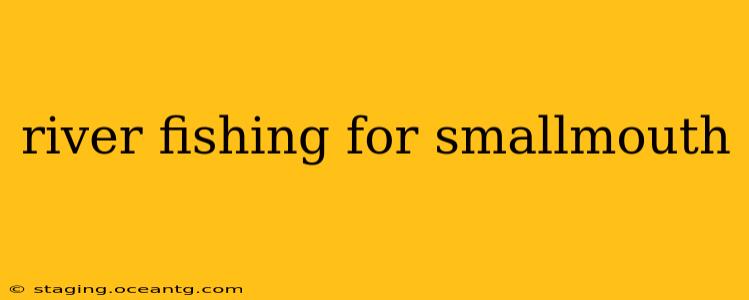Smallmouth bass, known for their aggressive strikes and acrobatic fights, are a prized catch for many anglers. River fishing for these feisty fish offers a unique challenge and reward compared to lake fishing. This comprehensive guide will delve into the techniques, tactics, and prime locations to help you land your next smallmouth trophy.
What are the best lures for river smallmouth bass?
The best lures for river smallmouth bass depend heavily on the river's flow, water clarity, and the structure present. However, some consistently productive choices include:
-
Spinnerbaits: These lures excel in stained or murky water, their flashing blades attracting attention from a distance. Choose spinnerbaits with Colorado or willow leaf blades, adjusting the weight to match the current.
-
Crankbaits: Crankbaits allow you to cover water quickly and effectively target different depths. Deep-diving crankbaits are excellent for exploring deeper pools and runs, while shallow-diving models work well in riffles and shallow areas.
-
Jerkbaits: These versatile lures imitate injured baitfish, triggering aggressive strikes from smallmouths. Their erratic action is especially effective in slow-moving water or around cover.
-
Tube jigs: Tube jigs are incredibly versatile, working well in various current speeds and depths. Their soft body allows for a natural presentation, mimicking small crayfish or fish.
-
Soft plastics (craws, worms, swimbaits): These versatile options are perfect for targeting smallmouths in a variety of cover. Rig them weightless or on a jig head, adjusting the weight based on the current.
What are the best times of day to catch smallmouth bass in a river?
Smallmouth bass are most active during periods of low light. Therefore, dawn and dusk are generally considered the best times to fish for them in a river. The cooler water temperatures and reduced sunlight make the bass more aggressive in their feeding habits. However, cloudy days can also provide excellent fishing opportunities throughout the day.
What is the best time of year to catch smallmouth bass in a river?
The best time of year to catch smallmouth bass in a river varies depending on geographic location, but generally, the spring and fall offer the most consistent action. Spring brings spawning activity, making smallmouths more aggressive. Fall offers cooler water temperatures, increased feeding activity as they prepare for winter, and vibrant fall foliage making river fishing even more scenic.
What are some good river fishing techniques for smallmouth bass?
Effective river fishing techniques focus on presenting your lure naturally and covering water efficiently:
-
Drift fishing: Let the current carry your lure downstream, allowing it to drift naturally through potential holding areas. This technique is highly effective when fishing deep pools and runs.
-
Upstream fishing: Cast your lure upstream and let it drift downstream naturally, mimicking a natural food source. This technique allows for a more controlled presentation.
-
Working the edges: Smallmouths often hold along the edges of current breaks, such as undercut banks, fallen logs, or rock piles. Concentrate your efforts on these areas.
-
Downstream fishing: Cast your lure across the current and retrieve it against the current. This technique is particularly effective when using crankbaits or spinnerbaits.
What are the best places to find smallmouth bass in a river?
Smallmouth bass prefer areas with:
-
Structure: Look for areas with rocks, logs, undercut banks, and other types of cover that provide ambush points.
-
Current breaks: Smallmouths often position themselves where the current slows down or changes direction.
-
Depth variations: Look for areas with a mixture of shallow and deep water.
-
Oxygenated water: Smallmouths require well-oxygenated water, so focus on areas with good water flow.
What size hooks and line should I use for river smallmouth bass?
The appropriate hook and line size depends on the size of the smallmouth bass you're targeting and the cover you're fishing. For most river fishing situations, a 6-8 pound test fluorocarbon line is a good starting point. Use hooks appropriate for your lure size, ensuring a secure hookset. Using heavier line may be necessary in areas with heavy cover.
By understanding the habits, habitats, and effective fishing techniques for smallmouth bass, you'll greatly increase your chances of a successful and rewarding river fishing experience. Remember to practice catch and release whenever possible to help conserve this valuable resource for future generations.
